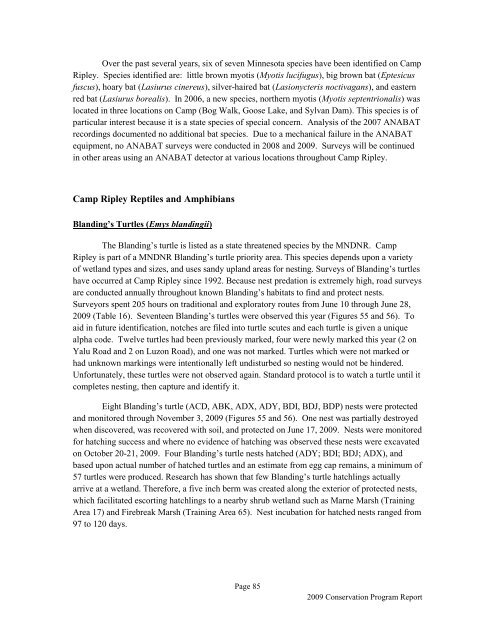camp ripley and arden hills minnesota army national guard training ...
camp ripley and arden hills minnesota army national guard training ...
camp ripley and arden hills minnesota army national guard training ...
Create successful ePaper yourself
Turn your PDF publications into a flip-book with our unique Google optimized e-Paper software.
Over the past several years, six of seven Minnesota species have been identified on Camp<br />
Ripley. Species identified are: little brown myotis (Myotis lucifugus), big brown bat (Eptesicus<br />
fuscus), hoary bat (Lasiurus cinereus), silver-haired bat (Lasionycteris noctivagans), <strong>and</strong> eastern<br />
red bat (Lasiurus borealis). In 2006, a new species, northern myotis (Myotis septentrionalis) was<br />
located in three locations on Camp (Bog Walk, Goose Lake, <strong>and</strong> Sylvan Dam). This species is of<br />
particular interest because it is a state species of special concern. Analysis of the 2007 ANABAT<br />
recordings documented no additional bat species. Due to a mechanical failure in the ANABAT<br />
equipment, no ANABAT surveys were conducted in 2008 <strong>and</strong> 2009. Surveys will be continued<br />
in other areas using an ANABAT detector at various locations throughout Camp Ripley.<br />
Camp Ripley Reptiles <strong>and</strong> Amphibians<br />
Bl<strong>and</strong>ing’s Turtles (Emys bl<strong>and</strong>ingii)<br />
The Bl<strong>and</strong>ing‟s turtle is listed as a state threatened species by the MNDNR. Camp<br />
Ripley is part of a MNDNR Bl<strong>and</strong>ing‟s turtle priority area. This species depends upon a variety<br />
of wetl<strong>and</strong> types <strong>and</strong> sizes, <strong>and</strong> uses s<strong>and</strong>y upl<strong>and</strong> areas for nesting. Surveys of Bl<strong>and</strong>ing‟s turtles<br />
have occurred at Camp Ripley since 1992. Because nest predation is extremely high, road surveys<br />
are conducted annually throughout known Bl<strong>and</strong>ing‟s habitats to find <strong>and</strong> protect nests.<br />
Surveyors spent 205 hours on traditional <strong>and</strong> exploratory routes from June 10 through June 28,<br />
2009 (Table 16). Seventeen Bl<strong>and</strong>ing‟s turtles were observed this year (Figures 55 <strong>and</strong> 56). To<br />
aid in future identification, notches are filed into turtle scutes <strong>and</strong> each turtle is given a unique<br />
alpha code. Twelve turtles had been previously marked, four were newly marked this year (2 on<br />
Yalu Road <strong>and</strong> 2 on Luzon Road), <strong>and</strong> one was not marked. Turtles which were not marked or<br />
had unknown markings were intentionally left undisturbed so nesting would not be hindered.<br />
Unfortunately, these turtles were not observed again. St<strong>and</strong>ard protocol is to watch a turtle until it<br />
completes nesting, then capture <strong>and</strong> identify it.<br />
Eight Bl<strong>and</strong>ing‟s turtle (ACD, ABK, ADX, ADY, BDI, BDJ, BDP) nests were protected<br />
<strong>and</strong> monitored through November 3, 2009 (Figures 55 <strong>and</strong> 56). One nest was partially destroyed<br />
when discovered, was recovered with soil, <strong>and</strong> protected on June 17, 2009. Nests were monitored<br />
for hatching success <strong>and</strong> where no evidence of hatching was observed these nests were excavated<br />
on October 20-21, 2009. Four Bl<strong>and</strong>ing‟s turtle nests hatched (ADY; BDI; BDJ; ADX), <strong>and</strong><br />
based upon actual number of hatched turtles <strong>and</strong> an estimate from egg cap remains, a minimum of<br />
57 turtles were produced. Research has shown that few Bl<strong>and</strong>ing‟s turtle hatchlings actually<br />
arrive at a wetl<strong>and</strong>. Therefore, a five inch berm was created along the exterior of protected nests,<br />
which facilitated escorting hatchlings to a nearby shrub wetl<strong>and</strong> such as Marne Marsh (Training<br />
Area 17) <strong>and</strong> Firebreak Marsh (Training Area 65). Nest incubation for hatched nests ranged from<br />
97 to 120 days.<br />
Page 85<br />
2009 Conservation Program Report
















